Pillars
Tour the Huang Engineering Center
Each floor of the Huang Engineering Center includes tributes to some of the most important people and places in the history of the School of Engineering. We think of them as pillars — central to the support structures that made the school a leader in impacting global issues.
First floor
Leland and Jane Stanford
Leland Stanford, a railroad magnate, California governor and U.S. senator, and his wife, Jane, established Stanford University to memorialize their son, Leland Jr., who died in 1884 at age 15. Jane Stanford was resolute that the university benefit society: “While the instruction offered must be such as will qualify the students for personal success and direct usefulness in life, they should understand that it is offered in the hope and trust that they will become thereby of greater service to the public.”
Location: Terrace Level
Brotherhood of Engineers

Engineering students were a substantial presence at Stanford from the start, with 141 of the first 559 students majoring in the field. Here, 21 “roughs” from the “brotherhood of engineers” strike poses near an engineering lab in 1912. The School of Engineering was founded in 1925.
Location: Terrace Level
Engineering Corner
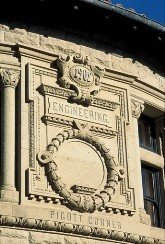
The Engineering Corner of the Quad opened in 1905 and remained the headquarters of engineering education until 1977, when the university dedicated the Terman Engineering Center. During the 50 years after the School of Engineering’s founding in 1925, the school built the international reputation for excellence that continues today.
Location: Forbes Family Café
Jen-Hsun Huang
MS ’92 Electrical Engineering
Co-Founder and CEO, NVIDIA Corporation
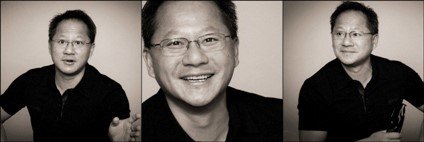
Jen-Hsun Huang has always followed his heart.
Born in Taipei, Huang moved at age 6 with his family to Bangkok and came to the United States at age 10. His parents wanted him to have the opportunities that America afforded. He developed an early passion for table tennis, becoming a nationally ranked junior player. In high school, he joined the computer club and discovered the magic of computers while playing games. His fascination led him to study computer science and chip design while an undergraduate at Oregon State University. He moved to Silicon Valley after graduation and worked at AMD and then LSI Logic. While pursuing his career and raising two young children, he enrolled part-time in Stanford’s graduate engineering program, where he found inspiration, particularly in the lectures of Professor (and future Stanford President) John Hennessy.
At Stanford, said Jen-Hsun, “I fell in love with computer design.”
Shortly after receiving his master’s degree, Jen-Hsun invested his drive and passion in co-founding NVIDIA with Chris Malachowsky and Curtis Priem. The company has since become the world leader in visual computing. Through its development of the graphics processing unit, or GPU, NVIDIA has brought the power of parallel processing to devices ranging from smartphones and tablets to workstations and supercomputers.
Location: Forbes Family Café
Second floor
Frederick E. Terman 1900-82
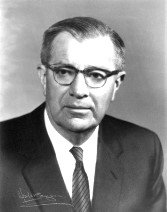
Professor of Electrical Engineering
Dean, School of Engineering
University Provost
Fred Terman’s legacy is legendary. His efforts to encourage development of and partnerships with local technology industry earned him the tagline “The Father of Silicon Valley.” His visionary leadership as dean of engineering and then university provost in recruiting the best faculty in key fields and in increasing government funding accelerated Stanford’s ascent to international renown. He also broke new ground in radio engineering research and teaching, and authored the field’s leading textbook.
But decades later, Terman cannot be reduced to a set of results, no matter how enduring. The personal qualities that he embodied remain a model for others who strive for excellence. Terman was a man not only of brilliant intellect but also of unshakeable concentration and dedication, both to Stanford as an institution and to the students and colleagues he served. His greatness lay not in wealth or glory, but in how many other people he helped inspire to greatness as well.
Location: Terman Engineering Library
Stanford Engineering Venture Fund
Leveraging the strong partnership between Stanford Engineering and the venture capital community in building Silicon Valley and propelling technology transfer, the Stanford Engineering Venture Fund (SEVF) I and II have played a pivotal role in the success of the Stanford School of Engineering. Since 1985, its committed volunteers have managed a portion of the school’s endowment with extraordinary results. The SEVF has provided Stanford Engineering with the critical resources necessary to seize new opportunities and to build a solid infrastructure for engineering research and teaching.
Proceeds from the fund have, among other things, established professorships, supported capital construction projects including the buildings in the Science and Engineering Quad, provided seed money for the Stanford Technology Ventures Program and served as matching funds for endowed graduate fellowships and professorships.
Location: Terman Engineering Library
Third floor
Palm Drive
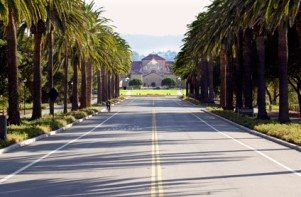
The most spectacular approach to campus is Palm Drive, which originates at the formal entrance to the university then splits to border the vast, grassy Oval in front of the Main Quad. The Science and Engineering Quad, precisely aligned along an axis with the Main Quad, realizes the vision of a series of quadrangles that the Stanfords developed with famed 19th-century landscape planner Frederick Law Olmsted.
Location: Mackenzie Room
Jen-Hsun Huang Engineering Center
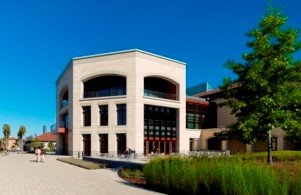
Named for alumnus and NVIDIA Corporation co-founder Jen-Hsun Huang, the building represents a vision of engineering as a discipline built on a foundation of solid technical knowledge and imbued with values of collaboration, creativity, lifelong learning, entrepreneurship and leadership. The Huang Engineering Center was formally dedicated Oct. 5, 2010.
Location: Mackenzie Room
